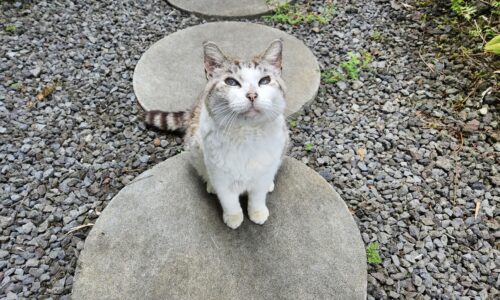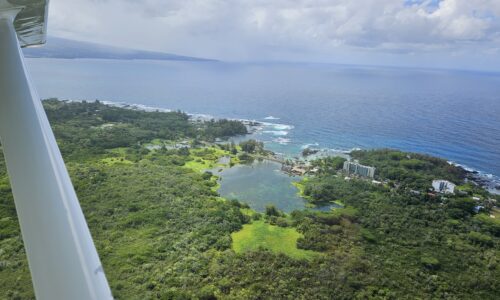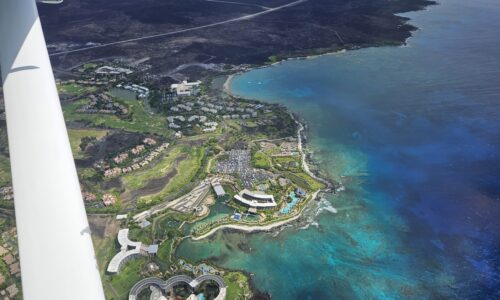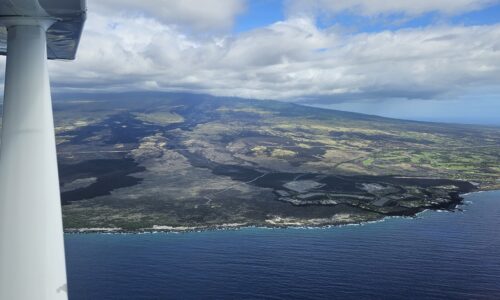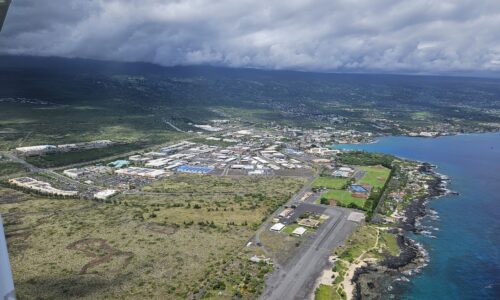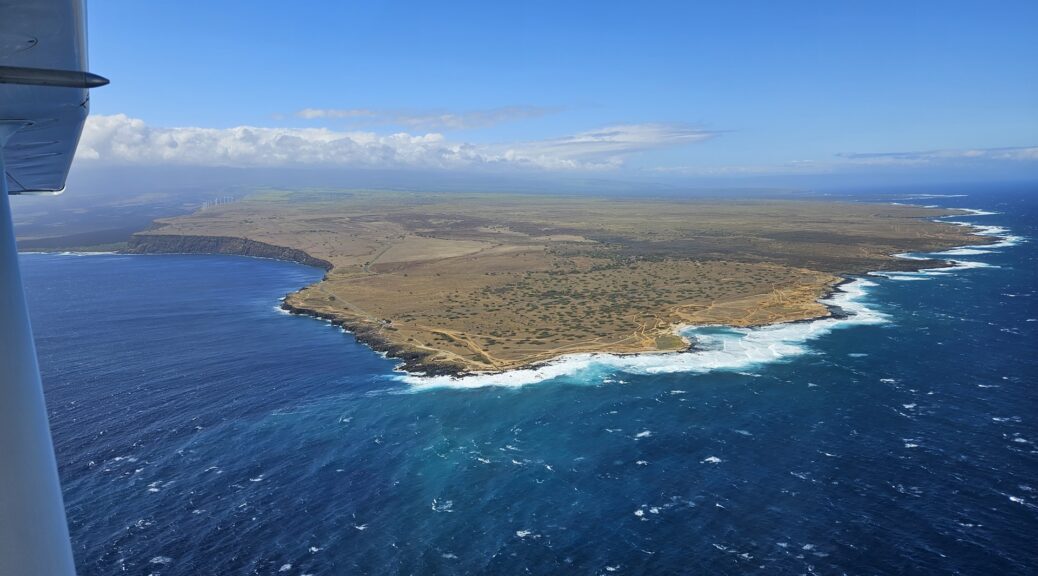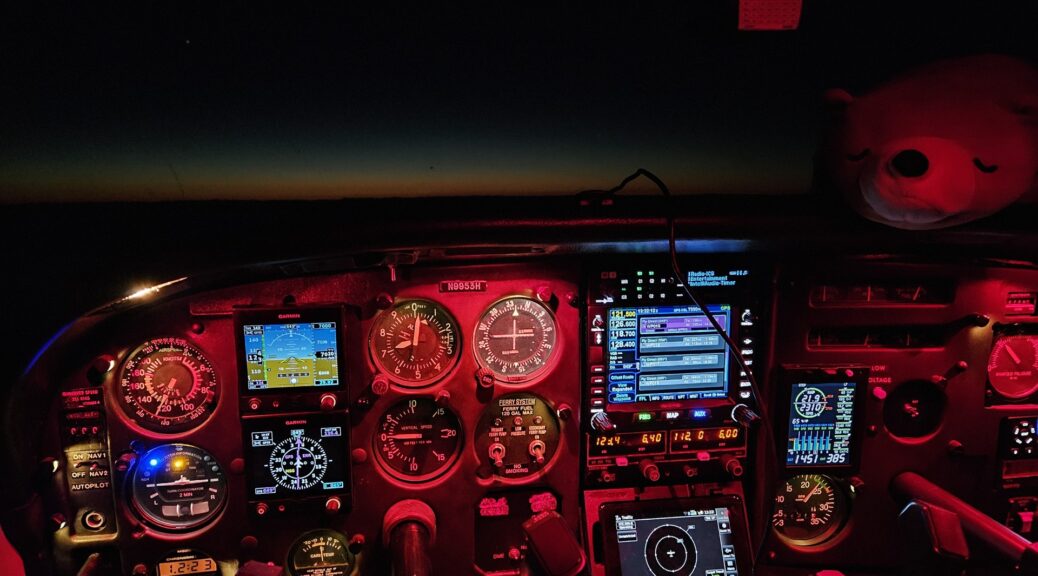Round the World – The Pacific, Part 12
It seemed foolish to set out on a 2,050 nautical mile flight after maintenance without performing a test flight first. I decided to make this a tour of the Big Island, to see a few new sights and land at a few new airfields. I flew anti-clockwise along the north coast first, towards the local airfield at Waimea.
I continued from Waimea south along the coast, past a collection of expensive luxury resorts to a touch and go landing at Kona International airport. The lava flows which we’d seen from the ground the previous day were every bit as impressive from the air.
Winds were blowing hard from the east and there was turbulence along the coast in the lee of the island. Things smoothed out as I approached the southernmost tip of the Big Island; the most southerly point of the fifty states.
As I flew back up the east coast I took the opportunity to overfly the crater at Kilauea, taking care not to enter the airspace around the volcano itself. My elevated position offered much more comprehensive views of the crater than we’d had at ground level. Hilo tower cleared me to land straight in from the south and I touched down on runway 03, taxiing to the GA parking area and shutting down.
I called Atlantic Aviation and they sent the fuel truck over. We topped off the four wing tanks before turning our attention to the ferry tank in the cabin. I had been watching the wind forecasts over the previous few days and things were not turning out as I had hoped. Although winds from the west were anecdotally more common, the best I was seeing in the foreseeable future were moderate headwinds over the first half of the route, swinging around to be sidewinds for the latter section.
As a result I wanted to carry plenty of fuel, and was keen to fit 150 gallons into the ferry tank. We filled the bladder slowly, pausing occasionally to adjust the tank and try to remove any wrinkles that might limit capacity. In the end we topped out at 149.8 gallons – good enough! In total I had taken on 212.8 gallons, bringing me to a fuel load on board of just over 260 gallons. The bill from Atlantic Aviation for Avgas came to a painful $2,067.83 – certainly my most expensive fill-up by quite a margin!
As I was leaving the airplane I ran into Scott, the local flight instructor who had very kindly been giving me all kinds of local tips and advice about operating in Hawaii. We’d interacted online, but this was our first time meeting in person, and it was great to be able to shake his hand and have a quick chat about my time in Hawaii and how helpful his information had been.
I returned the B&B for a final shower and to pack my small overnight bag, the only piece of luggage that I’d be carrying. After dropping off my rental car at the airport I took an Uber ride over to the General Aviation gate and secured my luggage in the rear under the cargo net. This would stop it from flying forwards and getting in the way in the event that I had to ditch. For the same reason the life raft was secured on the passenger seat to maximise my chances of bringing it with me if I needed to exit the aircraft in a hurry. I set up the HF radio on the seat next to it, along with my all-important drinks, snacks, and “Travel John” portable urinals. The final task was to put fresh batteries into my head torch; this was my back-up light in the event of the panel lights failing in the night.
I donned my life jacket, with its attached survival gear, and climbed into the pilot seat. This was harder than usual, as the seat could not slide back due to the presence of the full ferry tank. Starting the engine, I called for my IFR clearance and ran into the first problem. I had decided to leave several hours earlier than the time I had originally filed my flight plan for. I’d submitted an update to the flight plan and received confirmation from the commercial contractor who handles these things, Leidos. For whatever reason they had not passed it on to ATC. The tower controller was able to fix things with minimal delay and I was cleared to taxi to runway 08.
I took off and set Planey up for a slow but steady climb, lifting off at around 6pm. Despite a long take-off roll, aircraft performance was surprisingly good in this 20% overweight condition. I levelled off at 6,000ft as directed by ATC, settling in to a frustrating 25kt headwind. This was a little higher than forecast, but still within acceptable margins – just. Performance was solid, with Planey achieving 137kts of true airspeed on a fuel burn of 13.7 gallons an hour; the fuel totaliser calculated that at this rate I would arrive in Santa Maria with 8 gallons of fuel remaining. This would only get better as weight was burned off and winds became more favourable however. The apprehension that I had felt before takeoff on a flight of this magnitude had ebbed away now that I was on my way and things were looking good.
40 minutes into the flight, all that was left of the day was a glow on the western horizon over my left shoulder. Shortly after that I was handed over from Hilo on the VHF to San Francisco Radio on the HF – the night’s frequency was 8861. This radio check-in was a crucial step, as if I was unable to make contact then technically I would have had to turn back. Tonight the HF gods were smiling and I forged on into the darkness. Headwind had increased to 30 knots and I watched the miles tick away agonisingly slowly as calls from aircraft talking to Nandi and Auckland on the same HF channel kept me company.
ATC cleared me to climb to 7,000ft, where I was now achieving a true airspeed of 133kts on 12.7 gallons an hour. This was a slight improvement in efficiency already. They also cleared me for a “block altitude” between 5,000ft and Flight Level 200 (roughly 20,000ft). Effectively this meant that there was not a single other aircraft out here between these altitudes – I was truly on my own.

Three hours and twenty minutes into the flight I made the first transfer out of the ferry tank into the left main wing tank, which I had been running down since levelling off in cruise. The moonlight was bright enough to reveal a scattered layer of clouds below me. San Francisco Radio and I had agreed that I’d check in with them regularly, giving positions report on the hour every hour as well as at each of my flight-planned waypoints. At each report I would pass the report time, my positions and altitude, and the estimated arrival time at each of the next two waypoints.
This worked well until a new radio operator came on shift and, to be blunt about it, he was a real jerk. He would call me and ask for a position report for waypoints that I had already passed, and then have an attitude about it. In between his testy calls the other radio traffic had tailed off, with just the occasional call on the emergency frequency every now and then; an Air Canada flight headed for Sydney chatting with a United flight on its way to Seattle about ride conditions.
I passed the time through the night listening to music, reading, and watching television shows on my iPad. I also used the Garmin InReach to swap messages with friends and family, as well as receiving some encouraging messages from total strangers who had caught wind of the flight and were tracking my progress. Once again the Garmin came in very handy to check the latest weather information for my destination and I was happy to see that the forecast weather conditions remained benign.
Six and a half hours into the flight I made the second transfer from the ferry tank, followed thirty minutes later by transferring the contents of the tip tanks into the mains. A little over eight hours into the flight the first glimmer of dawn could be seen on the horizon ahead of me, and an hour later the sun rose above the horizon. The headwinds had been gradually subsiding as forecast and my groundspeed was now up to 128kts; the forecast fuel remaining on arrival rose alongside it.
Just over eleven hours into the flight a transmission came over the emergency frequency. It was a US Navy warship announcing their position (20 miles off my right wing), and declaring that they were initiating live fire exercises; all aircraft were to remain at least 50 miles clear. This caused me a little consternation and so I replied to let them know of my proximity. It seems that they were only transmitting and not listening however; nobody responded to me. I kept a close watch in their direction but didn’t see any missile trails. Apparently they decided not to send any ordinance in my direction.
Approaching twelve hours into the flight the headwinds had not entirely subsided, but were at least improved. The fuel totaliser settle on a forecast forty gallons of fuel on arrival with five and a half hours to go, which was a little over three hours of flying time. This felt quite comfortable.
Sixteen hours in, and a major milestone appeared; I was handed off from San Francisco Radio to LA Center on the VHF. Not long after they passed me on to the Santa Barbara approach controller. His welcomed me to the mainland, and asked me “So how long was that flight?” “We’re just coming up on sixteen hours and forty seven minutes”, I told him. All that came back was “Ouch”.
The restricted airspace around Vandenburg Space Force Base was inactive and I was cleared directly through it onto a downwind to land on runway 30 at Santa Maria. I taxied directly to the on-field hotel, looking forward to finally getting out of the cockpit and stretching my legs. To my great delight my father had flown over from the UK to greet me on my arrival. The hotel staff had rather unsportingly refused to allow him onto the apron so I headed over to open the door from airside and he joined me back at the airplane to uninstall the temporary HF; I’d be dropping it off here to be collected by its owner Stephen who had kindly lent it to me.
Dad and I made our way back in to the hotel to secure me a room. As we passed through the lobby a gentleman stood up and made his way over. Introducing himself as David, he told me that he’d been following the flight since the start of 2019, before I even took off. He lived near Santa Maria and first spotted me when browsing FlightAware and spotting a Cessna 182 arriving one night. Looking further, he saw that it had flown non-stop from Daytona Beach, Florida. This was my test flight for the ferry system, more than four years earlier, and he’d been keeping an eye on the website ever since.
After a few hours of sleep I met him and his friend down in the lobby to head out for dinner. We spent an enjoyable couple of hours in a nearby diner chatting about the flight as well as their own adventures, before they dropped me back at the hotel and I laid down for a long, deep sleep.
Click here to read the final part of the story.
